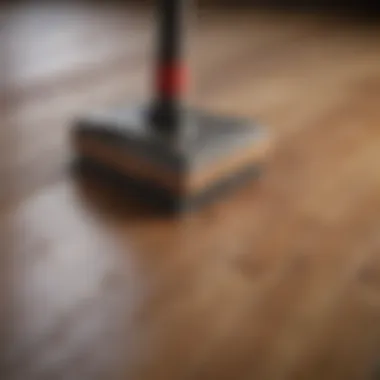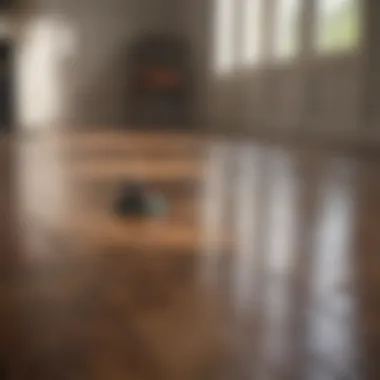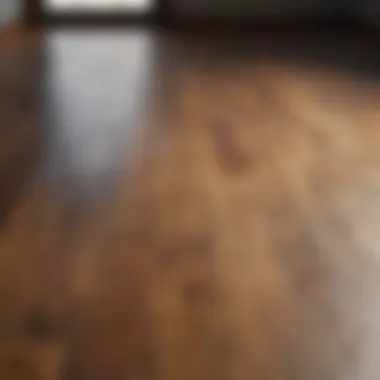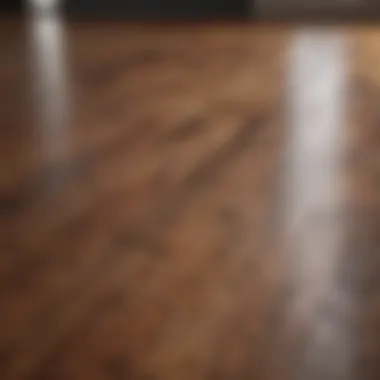Cleaning Wood Floors: Essential Prep Before Staining


Intro
Cleaning wood floors prior to staining is a pivotal step in ensuring a high-quality finish. Neglecting this task can lead to uneven coloring or surfaces that may not adhere well to the stain. Homeowners who wish to maintain or enhance the beauty of their wood floors must understand the significance of comprehensive cleaning practices. This guide will walk through the essential steps and methods needed to achieve a clean surface.
In addition to the process of cleaning, we will explore the necessary tools and materials. Common mistakes that can hinder the efficacy of the project will be highlighted, equipping readers with knowledge to avoid them. For those who appreciate interior design and care deeply about aesthetics, this guide serves not only as practical advice but also as a means to achieve stunning results in their wood flooring endeavors.
Understanding the Importance of Cleaning Wood Floors
Cleaning wood floors before staining is a crucial step for achieving optimal results. Many homeowners underestimate this process, assuming it is merely about aesthetics. In reality, thorough cleaning greatly affects how well the stain adheres to the surface. The process not only removes dirt and grime but also prepares the wood to absorb the stain evenly. By doing so, one ensures a consistent finish.
When wood is stained without proper cleaning, imperfections like dust particles or old finishes can interfere with the application. These issues may lead to blotches or uneven coloring, diminishing the floor's overall appearance. Therefore, dedicating time to this preparation phase is not just beneficial but essential for long-lasting results.
Moreover, regular maintenance, including pre-staining cleaning, extends the life of wooden floors. By maintaining their quality, homeowners can avoid costly repairs or refinishing in the future. The cleaning process is also a good opportunity to assess the condition of the floor, identifying any areas that may require further attention.
Why Pre-Staining Cleaning Matters
Pre-staining cleaning serves multiple purposes. First, it eliminates potentially harmful contaminants such as oils, waxes, and residues from cleaning products. These residues can create a barrier, impeding the stain's absorption. Thus, beginning with a clean slate is indispensable.
Additionally, the method used for cleaning wood floors requires attention. For instance, steam cleaning or utilizing harsh chemicals can damage the wood. Instead, gentle washes with suitable solutions are recommended to preserve the wood's surface while ensuring cleanliness.
Furthermore, the pre-cleaning phase provides insight into the floor's current state. Homeowners can easily spot damages like scratches, dents, or discoloration, allowing for timely repair. This further enhances the overall outcomes when the staining procedure begins.
Impact on Staining Outcomes
The impact of cleaning wood floors before applying a stain cannot be overstated. A well-prepared surface allows for optimal penetration of the stain, leading to improved color vibrancy and depth. When the surface is free from contaminants, the stain can interact fully with the wood fiber.
On the contrary, neglecting this crucial step may lead to uneven coloring. Areas that seem clean might actually have unnoticed grime, which prevents the stain from settling properly. This results in a patchy appearance that can be difficult, if not impossible, to correct post-application.
Moreover, the longevity of the stain is directly influenced by the cleanliness of the wood. A seal coat applied over a clean surface has a better chance of durability. In contrast, applying over a contaminated surface can reduce the lifespan of the finish, leading to early wear and tear.
Assessing Your Wood Floors
Assessing your wood floors is a crucial step before any cleaning or staining process. Proper evaluation provides insight into what methods and materials will be most effective. Ignoring this step can lead to complications down the line. The condition and type of wood directly influence how you clean and prepare for staining. Moreover, understanding these elements can prevent damage and ensure better adhesion of stains.
Identifying the Type of Wood
Identifying the type of wood is the first step in this assessment. Different wood species have varying characteristics, from hardness to porosity, which significantly affect cleaning and staining procedures. Some common types include oak, maple, cherry, and pine. Each type may require unique cleaning solutions or solvents. For instance, softwoods like pine can be more susceptible to scratches, while hardwoods are generally more durable.
Homeowners can typically find the type of wood by inspecting grain patterns or through manufacturer documentation if the flooring was installed recently. You might also consider taking a small sample to a professional for identification. Knowing your wood helps you select the right tools and cleaning agents while minimizing the risk of damage during the process.
Determining the Current Condition
The next step involves determining the current condition of your wood floors. This assessment includes identifying any scratches, stains, or areas of wear. Analyzing the condition aids in deciding what cleaning method will be most effective.
If your floors show significant wear, a deep cleaning followed by refinishing may be necessary before staining can occur. In contrast, lightly used floors might only need a basic cleaning routine. Common indicators to consider during this assessment include:
- Scratches or dents: Check for visible damage that can affect the finish.
- Discoloration or stains: Take note of water stains, pet accidents, or other marks.
- Loose boards: Ensure all floor sections are stable to avoid complications during cleaning.
Neglecting to assess the current condition properly may lead to prolonged cleaning times and undesirable staining results.


By carefully assessing these factors, you set the stage for a more successful cleaning and staining experience, benefiting both the appearance and longevity of your wood floors.
Essential Cleaning Supplies
In the realm of preparing wood floors for staining, the selection of appropriate cleaning supplies plays a vital role. Having the right cleaning solutions and tools can significantly influence the outcome of the staining process. Cleaning wood floors is not just about removing visible dirt; it requires a nuanced approach that mitigates potential damage and enhances the wood's natural grain. Thus, equipping yourself with the right essentials is imperative.
Cleaning Solutions
When discussing cleaning solutions, it is essential to consider both effectiveness and safety for wood surfaces. A suitable cleaning solution should not only efficiently remove grime but also be gentle enough to preserve the integrity of the wood. Here are some options:
- pH-neutral cleaners: These are designed to respect the wood's finish and prevent stripping away essential protective layers.
- Commercial wood floor cleaners: Many products exist specifically for wood floors, often featuring ingredients that enhance shine while cleansing. Brands like Bona and Murphy’s Oil Soap offer good options.
- Homemade solutions: A mixture of vinegar and water can work well if used correctly, diluted to avoid potential dulling of the finish. However, one should always test on a small, inconspicuous area first.
Thinking about the benefits of these solutions, it is clear that they not only remove dirt but can also preserve the finish of your wood floors. Investing in quality cleaners can ultimately save time and costs associated with redoing the staining process if mistakes are made.
Tools and Equipment
To complement the cleaning solutions, several tools are indispensable for an effective cleaning process. Here’s a closer look at essential tools:
- Microfiber mop: Unlike traditional mops, microfiber effectively traps dust and grime without scratching the wood.
- Soft-bristle broom: It is useful for sweeping up loose dirt before mopping.
- Vacuum with hardwood attachments: A vacuum that can handle hardwood floors ensures that fine dust is efficiently picked up, which traditional sweeping may miss.
- Scrub brush: For more stubborn stains, a soft scrub brush can help lift dirt without damaging the wood.
- Bucket: A bucket is necessary for diluting cleaning solutions and managing water during the cleaning process.
- Rags or towels: These will be essential for drying the floor thoroughly to prevent water damage.
Having the right tools is as crucial as selecting the proper cleaning solutions. Each item contributes to a thorough cleaning process, ensuring that your wood floors are both clean and well-maintained. A proper assessment of tools will aid in avoiding damage during cleaning, leading to better results when it comes to staining the floors. Consider investing in high-quality equipment that can endure repeated use. It pays off in the long run.
Preparation Steps
Preparing wood floors for staining is an essential phase that requires careful consideration and execution. Proper preparation ensures that the surface is free from debris and contaminants that can impede the staining process. This stage not only protects the investment in your wood floors but also optimizes the overall outcome when applying the stain. In this guide, we will cover the vital elements involved in preparation, including clearing the area and removing furniture safely. These steps help create a conducive environment for cleaning and staining.
Clearing the Area
Before proceeding with any cleaning or staining, it is crucial to clear the area where you will be working. This means removing any items like rugs, decorative pieces, and other belongings that may clutter the space. A clear environment not only allows for easier access to the floor but also helps prevent any accidental damage to furniture during the cleaning process.
When you clear the area, be mindful of the following:
- Ensure that the path to your cleaning supplies is unobstructed.
- Keep items organized in a designated area to avoid confusion.
- Don’t just move things to another room; consider where you place them to avoid any potential damage or disturbance.
By taking these steps, you create a safer workspace and set the stage for a more efficient cleaning process, ultimately benefiting the staining results.
Removing Furniture Safely
The next important step is removing furniture safely. This can be a challenging task, especially if the pieces are heavy or bulky. Lifting heavy furniture can cause injury, so using proper techniques is essential. Here are some key points to consider:
- Disassemble when possible: If the furniture can be taken apart, it is wise to do so. This reduces weight and simplifies the moving process.
- Use furniture sliders: These tools can help you move heavy pieces across the floor without scratching it. Simply place them under the legs of the furniture.
- Plan your route: Before moving items, plan how you will navigate through the space to avoid tripping hazards or bumping into walls.
"Removing furniture safely not only protects your belongings but also minimizes risk to your wood floors during the cleaning process."
It is essential to approach furniture removal with care. Proper preparation here ensures that no damage occurs to either the furniture or the wood floors, providing a clean slate for the upcoming cleaning and staining tasks.
By following these preparation steps, you position yourself for success, ensuring that the cleaning process is smooth and effective.
Cleaning Methods
Cleaning methods play a crucial role in the process of preparing wood floors for staining. The effectiveness of these methods directly influences the final appearance of the stained surface. A well-executed cleaning routine removes dust, debris, and grease, all of which can disrupt the bonding of the stain to the wood. For those aiming for superior results, understanding the different cleaning methods is essential.


There are primarily two types of cleaning methods: dry cleaning techniques and wet cleaning processes. Each method has distinct advantages and considerations that affect the overall cleanliness of your wood floors. Selecting the appropriate method based on your floor's condition can enhance both the staining process and the wood's longevity.
Dry Cleaning Techniques
Dry cleaning techniques are often the first step in cleaning wood floors. This method utilizes dry tools to remove loose dirt and dust before applying any liquid solutions. Here are some common dry cleaning techniques:
- Dust Mopping: Regularly dust mopping with a microfiber mop is effective for capturing fine particles. This should be done frequently to minimize build-up.
- Vacuuming: Using a vacuum with a soft brush attachment is excellent for reaching corners and crevices where dirt accumulates. Make sure the vacuum is suitable for hard floors to avoid scratches.
- Brooming: A soft-bristle broom can be used for quick clean-ups. However, be cautious of using too much pressure, which could damage delicate finishes.
In dry cleaning, it is important to avoid using abrasive materials that could scratch the wood's surface. These techniques are especially beneficial in maintaining cleanliness between deeper cleanings.
Wet Cleaning Process
Once dry cleaning methods have been employed, a wet cleaning process can be initiated to address stickier stains and embedded dirt. This method requires more care to prevent water damage. Here are steps to follow:
- Choose an Appropriate Cleaner: Select a cleaner specifically formulated for wood floors, such as Bona Hardwood Floor Cleaner or Murphy Oil Soap.
- Damp Mopping: Use a microfiber mop moistened with the cleaner to gently wipe the floors. Avoid soaking the mop; excess water can seep into the wood and cause damage.
- Rinse with Clean Water: After mopping with a cleaner, it may be useful to go over the floor with a mop dampened only with clean water to remove any residue.
Implementing a wet cleaning process can help remove more profound stains and prepare the surface for staining better. However, it is crucial to ensure the floor dries adequately before proceeding.
Spot Cleaning Stains
Spot cleaning is necessary for addressing specific stains or marks that the previous cleaning methods may not have removed. This technique requires attention to detail and often involves a more direct application of cleaning agents. Here are some strategies for effective spot cleaning:
- Identify the Stain: Knowing what caused the stain, whether it’s food, beverages, or pet accidents, can guide the choice of cleaning agent.
- Apply a Suitable Cleaner: For water-based stains, using a damp cloth with a wood cleaner is advisable. For oil-based stains, consider using a small amount of mineral spirits but test it in an inconspicuous area first.
- Gentle Scrubbing: Use a soft, non-abrasive cloth or sponge to gently scrub the stain. Never apply too much force, as this can damage the finish.
Spot cleaning effectively restores the appearance of wood floors, ensuring that every area is ready for staining. A well-prepared surface contributes to an even application of stain, enhancing the overall look of your flooring.
Combining these methods ensures a thorough cleaning process. Each step in the cleaning methods discussion is critical to achieving a clean, smooth surface on which to apply your stain. Proper cleanliness leads to a robust finish that enhances the wood floors' beauty.
Drying and Preparing for Staining
Preparing wood floors for staining involves not just cleaning, but also ensuring they are dry and ready for the application of stain. The process of drying has significant implications for the overall finish and durability of the wood flooring. Properly drying the surface is crucial to achieving an even application and preventing issues such as splotches or uneven color.
Ensuring Complete Dryness
After cleaning the wood floors, it is essential to allow ample time for them to dry thoroughly. This step cannot be overlooked as moisture trapped in the wood can interfere with the penetration of the stain, leading to suboptimal results. To check for complete dryness, one can follow these steps:
- Visual Inspection: Look for any signs of dampness or lingering moisture on the surface. The wood should appear uniform in color, without any dark spots indicating wetness.
- Touch Test: Run your hand across the surface. If it feels cool or moist to the touch, the floor is not adequately dried.
- Time Consideration: Depending on the humidity and temperature of the environment, drying times can vary. Generally, a few hours of drying time is sufficient, but a day is often recommended for ideal conditions.
In humid or cooler environments, it may take longer. Using fans or dehumidifiers can help accelerate the drying process. Ensuring that the floors are completely dry is a critical step that allows the staining process to yield the desired aesthetic and longevity.
Final Inspection Before Staining
Once drying is complete, a final inspection of the wood floors should be conducted. This involves assessing the surface for any remnants of dust, debris, or imperfections.
During this inspection, consider the following:
- Check for Residue: Any leftover particles can affect how the stain adheres to the wood. It is advisable to wipe the surface with a clean, dry cloth to remove any dust or residue remnants.
- Examine for Damage: Look for scratches, dents, or any other damage that was not addressed during the cleaning phase. Small damages can often be repaired easily before staining.
- Evaluate Staining Requirements: Depending on the type of stain being used, different preparation might be necessary. Some stains may require a light sanding or a specific primer.
Important Note: Properly preparing and inspecting your wood floors ensures that the final stain application will be both beautiful and durable. A well-prepared surface can prevent common staining issues and enhance the overall finish.


By focusing on both drying and final inspections, homeowners significantly improve their chances of achieving the stunning results they aim to attain. Staining is, after all, a craft that benefits greatly from meticulous preparation.
Common Mistakes to Avoid
Cleaning wood floors before staining is a critical step in ensuring a successful outcome. Yet, many homeowners run into trouble due to common mistakes they make during this process. Understanding these pitfalls is essential. By avoiding these errors, one can significantly improve the effectiveness of cleaning efforts and enhance the final aesthetics of the stained wood floor.
Using Incorrect Cleaning Products
One of the most significant mistakes is using incorrect cleaning products. Not all cleaners are suitable for wood floors. Some contain harsh chemicals that can damage the finish or the wood itself.
- Avoid products containing ammonia: Ammonia can strip the natural oils from the wood, leading to dryness and potential cracking.
- Stay clear of vinegar-based solutions: While vinegar is effective for some cleaning tasks, it can dull wood finishes over time.
- Use pH-neutral cleaners: Look for cleaning solutions specifically designed for wood floors. These products maintain the integrity of the wood while effectively removing dirt and grime.
It's advisable to read the labels of cleaning products carefully. A wrong choice can lead to irreversible damage, increasing the cost and effort required to rectify the problem. Ultimately, the wrong cleaner can affect how the stain adheres to the wood, resulting in uneven coloration or peeling.
Skipping Pre-Cleaning Steps
Another frequent error is skipping essential pre-cleaning steps. Some homeowners might feel eager to stain their floors and overlook vital preparatory actions. This inclination can lead to problematic outcomes.
- Neglecting to sweep or dust: Before applying any cleaning solution, it is crucial to remove dust and debris from the surface. Failing to do so can trap dirt in the wood grain, leading to a compromised finish.
- Ignoring spot treatment: Before general cleaning, it is wise to treat specific stains or spots on the wood floor. Neglecting this can result in unsightly blemishes that remain visible even after staining.
- Overlooking moisture control: Ensure the floor is not excessively damp prior to staining. Staining on wet wood can lead to uneven absorption and poor stain adherence.
By taking the time to follow all necessary pre-cleaning steps, homeowners set the stage for a successful staining job. This diligence helps in securing a beautiful finish that lasts longer, adding value to the property.
Post-Cleaning Care and Maintenance
After the thorough cleaning of wood floors, maintaining their cleanliness and care becomes essential. Proper post-cleaning care can significantly influence the durability and appearance of your wood floors. Consistent attention to their maintenance ensures that the beauty of your flooring is preserved and that it remains protected against potential damage.
Maintaining Cleanliness after Staining
Once the staining process is complete, it is important to keep the floor clean to prevent premature wear and damage to the new finish. Here are some steps to ensure that your newly stained wood floor remains pristine:
- Avoid Water Exposure: Minimize the amount of water used for cleaning during the initial weeks after staining. Excess moisture can damage the new finish.
- Use Soft Tools: Utilize soft brooms or dust mops instead of traditional vacuums that may scratch the surface.
- Implement a No-Shoe Policy: Establishing a rule against shoes on the floor, particularly for the first few weeks, can reduce dirt and grit.
- Regular Dusting: Frequent dusting with a microfiber cloth helps to remove any particles that may scratch the surface.
Adhering to these practices limits the risk of wear and keeps your floors looking their best.
Long-Term Care for Wood Floors
Long-term care for wood floors involves regular maintenance routines and addressing issues promptly. Elements like environmental factors and foot traffic can affect the floors over time. Here are key practices to consider for long-term care:
- Apply Floor Mats: Placing mats at entry points reduces dirt intake and protects against moisture.
- Use Furniture Pads: For heavy furniture, use felt pads to avoid scratches when moving items.
- General Cleaning Routine: Create a schedule for cleaning that includes dusting, mopping with suitable products, and inspections for wear or damage.
- Periodic Refinishing: Depending on the type of finish and traffic levels, you may need to refinish your floors every several years. This process restores their luster and protects the wood beneath.
Consistent care prevents unexpected damage and preserves the quality of wood floors, nurturing their aesthetic appeal for years to come.
Engaging in thorough post-cleaning care and long-term maintenance of wood floors is crucial. It protects your investment and enhances your home’s overall charm.
Finale
In this article, we have explored the critical steps involved in cleaning wood floors before applying stain. Understanding the importance of thorough cleaning cannot be overstated, as it directly influences how well the stain adheres and its overall appearance. By preparing adequately, you set the stage for a successful staining process that enhances the beauty of your wood floors and prolongs their lifespan.
Summarizing Key Takeaways
To summarize, here are the key takeaways from this guide:
- Importance of Pre-Cleaning: Proper cleaning before staining ensures an even and beautiful finish. Residual dirt and grime can disrupt the staining process, resulting in splotchy and unattractive surfaces.
- Right Tools and Supplies: Utilizing the correct cleaning products and equipment is essential. This ensures efficient cleaning without damaging the wood.
- Avoiding Common Mistakes: Being aware of common pitfalls, such as using harsh chemicals or skipping the dry cleaning phase, can save time and resources.
- Post-Cleaning Care: After staining, maintaining the cleanliness of your floors is crucial for their longevity and appearance. Regular care will keep them looking vibrant.
Encouragement for Careful Preparation
Overall, careful preparation prior to staining is an investment worth making. It not only enhances the final appearance but also ensures the durability of your wood floors. Take the time to assess your floors, choose appropriate cleaning methods, and perform a thorough cleaning. By dedicating effort to these preliminary steps, homeowners can achieve stunning results that augment the aesthetic of their space. Proper care and attention lead to a beautiful finish that elevates both enjoyment and value in your home.







